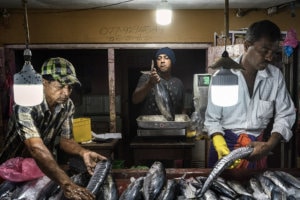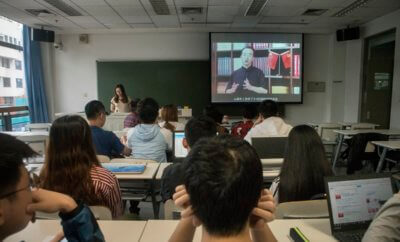Business
Behind on Payments to China, Sri Lanka Coughed Up Territory Instead

Former President Mahinda Rajapaksa of Sri Lanka, center, at a wedding in Colombo, Sri Lanka, June 6, 2018.
Photo: Adam Dean/The New York Times
The handover of Hambantota port in Sri Lanka to the Chinese has kept alive concerns about possible military use.
Every time Sri Lanka’s president, Mahinda Rajapaksa, turned to his Chinese allies for loans and assistance with an ambitious port project, the answer was yes.
Yes, though feasibility studies said the port wouldn’t work. Yes, though other frequent lenders like India had refused. Yes, though Sri Lanka’s debt was ballooning rapidly under Rajapaksa.
Over years of construction and renegotiation with China Harbor Engineering Co., one of Beijing’s largest state-owned enterprises, the Hambantota Port Development Project distinguished itself mostly by failing, as predicted. With tens of thousands of ships passing by along one of the world’s busiest shipping lanes, the port drew only 34 ships in 2012.
And then the port became China’s.
Rajapaksa was voted out of office in 2015, but Sri Lanka’s new government struggled to make payments on the debt he had taken on. Under heavy pressure and after months of negotiations with the Chinese, the government handed over the port and 15,000 acres of land around it for 99 years in December.
The transfer gave China control of territory just a few hundred miles off the shores of a rival, India, and a strategic foothold along a critical commercial and military waterway.
The case is one of the most vivid examples of China’s ambitious use of loans and aid to gain influence around the world — and of its willingness to play hardball to collect.
The debt deal also intensified some of the harshest accusations about President Xi Jinping’s signature Belt and Road Initiative: that the global investment and lending program amounts to a debt trap for vulnerable countries around the world, fueling corruption and autocratic behavior in struggling democracies.

A view of the Port of Colombo in Colombo, Sri Lanka, May 1, 2018. Photo Credit: Adam Dean/The New York Times
Months of interviews with Sri Lankan, Indian, Chinese and Western officials, and analysis of documents and agreements stemming from the port project, present a stark illustration of how China and the companies under its control ensured their interests in a small country hungry for financing.
During the 2015 Sri Lankan elections, large payments from the Chinese port construction fund flowed directly to campaign aides and activities for Rajapaksa, who had agreed to Chinese terms at every turn and was seen as an important ally in China’s efforts to tilt influence away from India in South Asia. The payments were confirmed by documents and cash checks detailed in a government investigation seen by The New York Times.
Though Chinese officials and analysts have insisted that China’s interest in the Hambantota port is purely commercial, Sri Lankan officials said that from the start, the intelligence and strategic possibilities of the port’s location were part of the negotiations.
— Initially moderate terms for lending on the port project became more onerous as Sri Lankan officials asked to renegotiate the timeline and add more financing. And as Sri Lankan officials became desperate to get the debt off their books in recent years, the Chinese demands centered on handing over equity in the port rather than allowing any easing of terms.
— Though the deal erased roughly $1 billion in debt for the port project, Sri Lanka is now in more debt to China than ever, as other loans have continued and rates remain much higher than from other international lenders.
Rajapaksa and his aides did not respond to multiple requests for comment, made over several months, for this article. Officials for China Harbor also would not comment.
Estimates by the Sri Lankan Finance Ministry paint a bleak picture: This year, the government is expected to generate $14.8 billion of revenue, but its scheduled debt repayments, to an array of lenders around the world, come to $12.3 billion.
“John Adams said infamously that a way to subjugate a country is through either the sword or debt. China has chosen the latter,” said Brahma Chellaney, an analyst who often advises the Indian government and is affiliated with Center for Policy Research, a think tank in New Delhi.
Indian officials, in particular, fear that Sri Lanka is struggling so much that the Chinese government may be able to dangle debt relief in exchange for its military’s use of assets like the Hambantota port — though the final lease agreement forbids military activity there without Sri Lanka’s invitation.
“The only way to justify the investment in Hambantota is from a national security standpoint — that they will bring the People’s Liberation Army in,” said Shivshankar Menon, who served as India’s foreign secretary and then its national security adviser as the Hambantota port was being built.

A fish stall in a zone that is due to be turned into a large industrial area surrounding the Hambantota Port, in Ambalantota, Sri Lanka, March 10, 2018. Photo Credit: Adam Dean/The New York Times
From the start, officials questioned the wisdom of a second major port, in a country a quarter the size of Britain and with a population of 22 million, when the main port in the capital was thriving and had room to expand. Feasibility studies commissioned by the government had starkly concluded that a port at Hambantota was not economically viable.
But Rajapaksa greenlighted the project, then boasted in a news release that he had defied all caution — and that China was on board.
The Sri Lanka Ports Authority began devising what officials believed was a careful, economically sound plan in 2007, according to an official involved in the project. It called for a limited opening for business in 2010, and for revenue to be coming in before any major expansion.
The first major loan it took on the project came from the Chinese government’s Export-Import Bank, or Exim, for $307 million. But to obtain the loan, Sri Lanka was required to accept Beijing’s preferred company, China Harbor, as the port’s builder, according to a U.S. Embassy cable from the time, leaked to WikiLeaks.
That is a typical demand of China for its projects around the world, rather than allowing an open bidding process. Across the region, Beijing’s government is lending out billions of dollars, being repaid at a premium to hire Chinese companies and thousands of Chinese workers, according to officials across the region.
In later years, Chinese officials and the China Harbor company went to great lengths to keep relations strong with Rajapaksa, who for years had faithfully acquiesced to such terms.
In the final months of Sri Lanka’s 2015 election, China’s ambassador broke with diplomatic norms and lobbied voters, even caddies at Colombo’s premier golf course, to support Rajapaksa over the opposition, which was threatening to tear up economic agreements with the Chinese government.
The rising debt and project costs, even as the port was struggling, handed Sri Lanka’s political opposition a powerful issue, and it campaigned heavily on suspicions about China. Rajapaksa lost the election.
The incoming government, led by President Maithripala Sirisena, came to office with a mandate to scrutinize Sri Lanka’s financial deals. It also faced a daunting amount of debt: Under Rajapaksa, the country’s debt had increased threefold, to $44.8 billion when he left office. And for 2015 alone, a $4.68 billion payment was due at year’s end.
The new government was eager to reorient Sri Lanka toward India, Japan and the West. But officials soon realized that no other country could fill the financial or economic space that China held in Sri Lanka.
Government officials began meeting in 2016 with their Chinese counterparts to strike a deal, hoping to get the port off its balance sheet and avoid outright default. But the Chinese demanded that a Chinese company take a dominant equity share in the port in return, Sri Lankan officials say — writing down the debt was not an option.
The handover of Hambantota to the Chinese has kept alive concerns about possible military use — particularly as China has continued to militarize island holdings around the South China Sea despite earlier pledges not to.
Sri Lankan officials are quick to point out that the agreement explicitly rules out China’s military use of the site. But others also note that Sri Lanka’s government, still heavily indebted to China, could be pressured to allow it.
And, as Harsha de Silva, the state minister for national policies and economic affairs, put it, “Governments can change.”
© 2018 New York Times News Service



